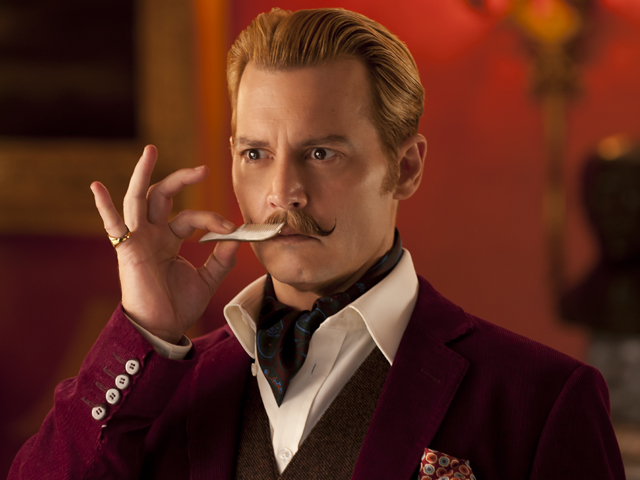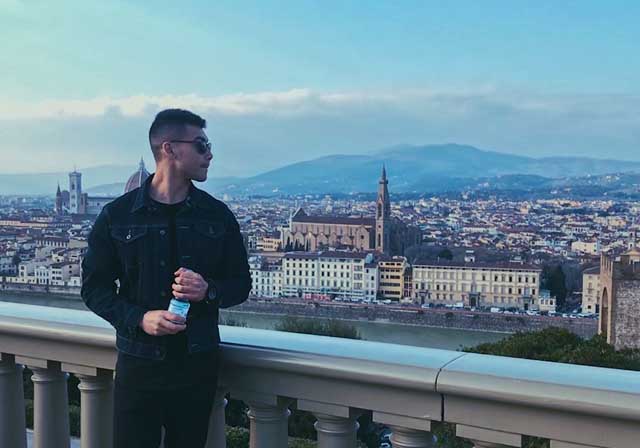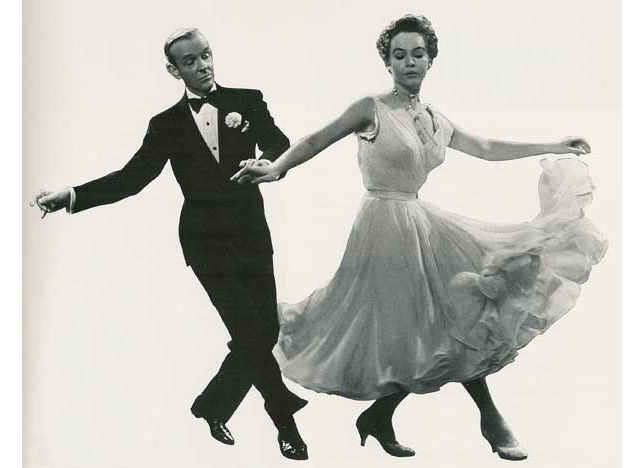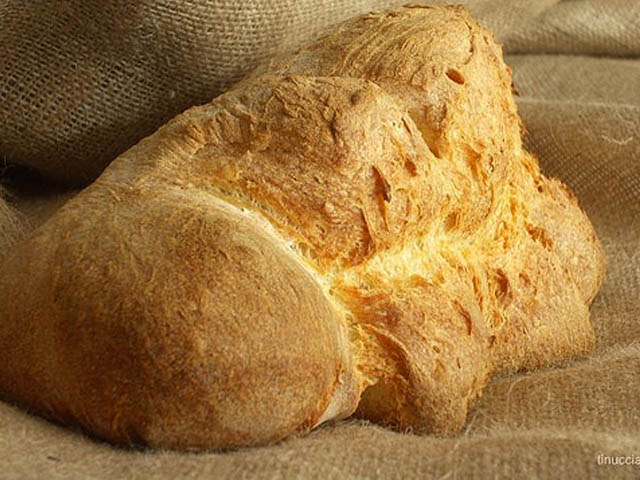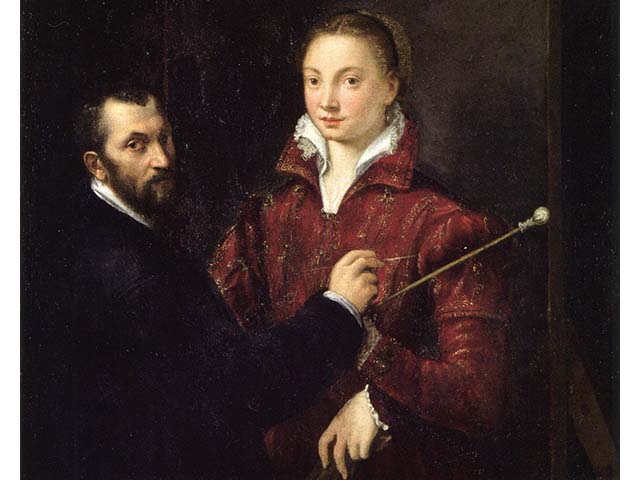
Bernardino Campi Painting Sofonisba Anguissola
Sofonisba Anguissola—try to repeat
that name three times fast!
Il nome Sofonisba Anguissola non rotola necessariamente facilmente dalla lingua. Per aiutarti a pronunciare il suo nome l’ho suddiviso: Sofo-nees-bah Ahn-gwee-sola.
The name Sofonisba Anguissola doesn’t necessarily roll off the tongue easily. To help you pronounce her name I’ve broken it down: Sofo-nees-bah Ahn-gwee-sola.
Sofonisba Anguissola è un nome insolito, ma è anche un nome che, per molti anni, è passato inosservato e, per la maggior parte, dimenticato insieme ai suoi quadri magistrali. Ma, recentemente, Sofonisba ha guadagnato più attenzione, e dipinti erroneamente accreditati ad artisti maschi dell’epoca—poiché alcuni non potevano o piuttosto non avrebbero accettato che una donna potesse dipingere così come o meglio degli uomini—vengono ora riassegnati alla sua pera. Sofonisba sta guadagnando la notorietà che prime le mancava.
Not only is Sofonisba Anguissola an unusual name, but it is also a name that, for many years, has gone unnoticed and, for the most part, forgotten along with her masterful paintings. But, recently, Sofonisba has been gaining more attention, and paintings wrongly credited to male artists of the time—as some could not or rather would not accept a woman could paint as well as or better than men—are now being reassigned to her oeuvre. Sofonisba is gaining the notoriety she previously lacked.
Sofonisba Anguissola is back in the public
eye and the subject of my new novel!
After learning more about Sofonisba, I was so intrigued by her—I decided to turn her story into a new historical fiction novel called: “The Secret Life of Sofonisba Anguissola—the most famous woman you’ve never heard of.”
The novel will be released the first week
of December and will be
available in print and epub.
Learn more book news on MelissaMuldoon.com Author Website
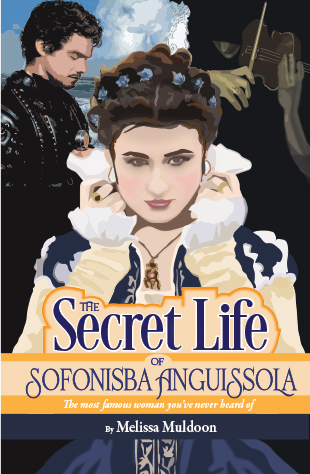
Sofonisba was lauded by Michelangelo and Vasari—the first to record the history of contemporary artists
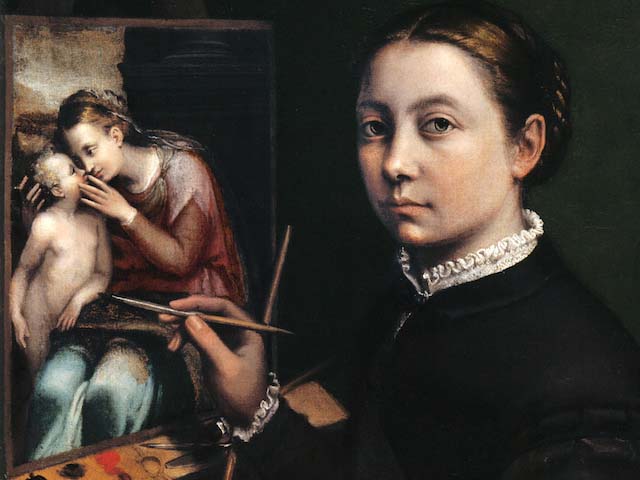
Il lavoro di Sofonisba mostra potenza, forza ed emozione, oltre a drammatici chiaroscuri molto prima di Caravaggio. È come Rembrandt, era una prolifica autoritrattista, celebrava il suo status di artista, mostrando un interesse per il passare del tempo e il suo posto unico al mondo. Si scopre che Sofonisba Anguissola era davvero una donna, artista e ritrattista meravigliosa, che ha vissuto una vita lunga ed emozionante. In effetti, si è guadagnata la stima e l’elogio di un altro pittore—forse ne hai sentito parlare prima? Michelangelo!
Sofonisba’s work shows power and strength and emotion, as well as dramatic chiaroscuro long before Caravaggio. And like Rembrandt, she was a prolific self-portraitist, celebrating her status as an artist, displaying a keen interest in the passing of time and her own unique place in the world. It turns out Sofonisba Anguissola really was a marvelous woman, artist, and portrait painter, who lived a long and exciting life. In fact, she earned the regard and praise of another painter — perhaps you’ve heard of him before? Michelangelo!
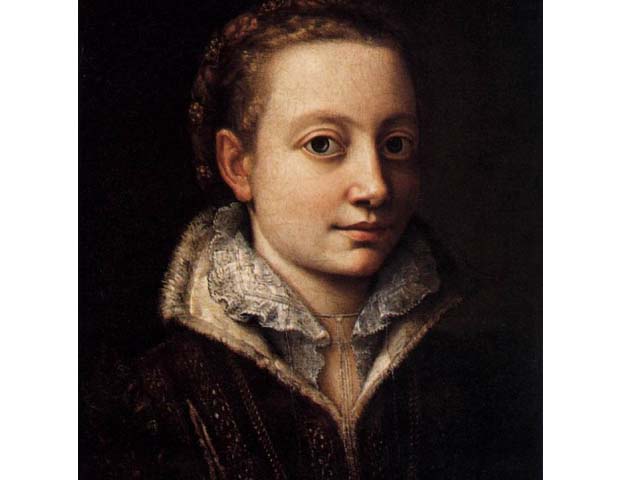
Infatti! Sofonisba, a detta di tutti, è stata un talentuoso pittore del XV secolo. La prima volta che sentiamo parlare di Sofonisba è nelle “Vite dell’artista” scritto da Giorgio Vasari in cui la loda:
Indeed! Sofonisba, by all accounts, was a talented painter of the fifteenth century. The first we hear of Sofonisba is in Giorgio Vasari’s “Lives of the artists” in which he praises her:
“Sofonisba, has labored at the difficulties of design with greater study and better grace than any other woman of our time, and she has not only succeeded in drawing, coloring, and copying from nature, and in making excellent copies of works by other hands, but has also executed by herself alone some very choice and beautiful works of painting.”
Giorgio Vasari
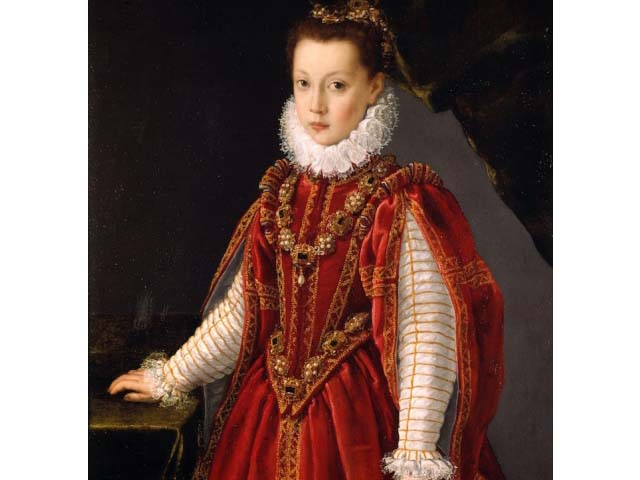
Ecco un piccolo retroscena sulla meravigliosa
Signorina Anguissola!
Here’s a little back story on
the marvelous Miss Anguissola!
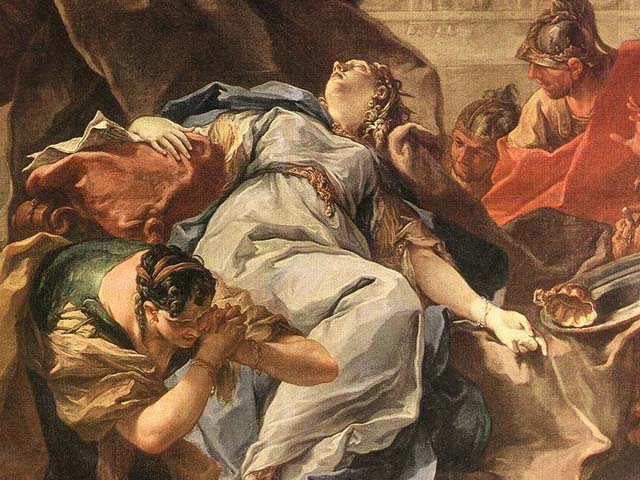
Sofonisba Anguissola nacque a Cremona, in Italia, nel 1532 da un famiglia relativamente povera ma nobile. Il suo nome la contraddistingue e la rende unica. Fu chiamata Sofonisba da suo padre Amilcare, che era molto orgoglioso dell’eredità della sua famiglia, facendola risalire ai romani e agli antichi cartaginesi. Sophonisba (ortografatto con il greco “ph”) era il nome di un 3 secolo a.c. principessa cartaginese che si è avvelenata perché non voleva essere violentata dai romani che hanno vinto la guerra punica.
Sofonisba Anguissola was born in Cremona, Italy, in 1532 to a relatively poor but noble family. Her name alone sets her apart and makes her quite unique. She was named Sofonisba by her father Amilcare, who took great pride in his family’s heritage, tracing it back to the Romans and ancient Carthaginians. Sophonisba (spelled with the Greek “ph”) was the name of a 3rd century B.C. Carthaginian Princess poisoned herself because she did not want to be ravished by the Romans who won the Punic war.
Ma, a differenza della principessa cartaginese, la Sofonisba del XV secolo mostrò più coraggio e resistenza, prendendo dietro un altro ramo della famiglia che aveva forti legami con il generale bizantino Galvano Sordo che aiutò a liberare la città di Costantinopoli. Quando la battaglia fu vinta, la gente gridò: “Anuis sola fecit victoriam: Il serpente ha portato la vittoria.” Questo detto divenne poplare e Galvano fu soprannominato “Anguissola” e così il cognome di famiglia rimase.
But, unlike the Carthaginian princess, the 15th-century Sofonisba showed more gumption and stamina, taking after another branch of the family that had strong connections with the Byzantine general Galvano Sordo who helped liberate the city of Constantinople. When the battle was won, the people cried: “Anuis sola fecit victoriam: The snake alone brought the victory.” This saying became popular, and Galvano was nicknamed “Anguissola” and thus the familial surname stuck. (note: Anguilla in Italian means snake or eel.)
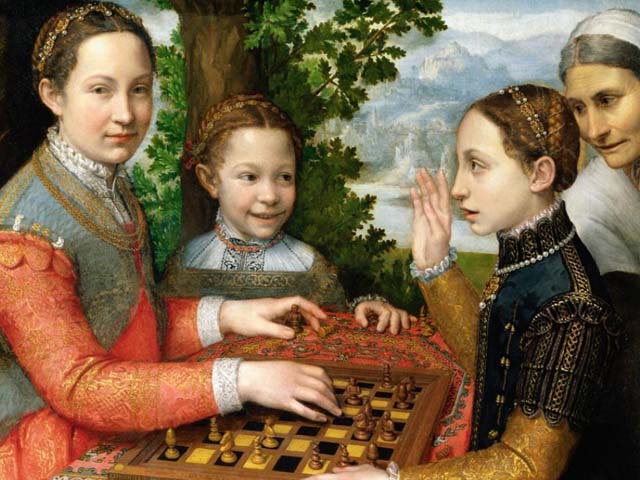
Fin dalla tenera età, Sofonisba è stata incoraggiata a dipingere. Proveniva da una grande famiglia composta da sette fratelli, molti dei quali erano anche pittori. Ma è stata Sofonisba a mostrare la promessa più eccezionale. Da giovane, ricevette un’istruzione a tutto tondo che includeva apprendistati con pittori locali, il più influente dei quali Bernadino Campi, che costituì un precedente per le donne accettate come studentessa d’arte.
From an early age, Sofonisba was encouraged to paint. She hailed from a large family consisting of seven siblings, several of whom were also painters. But it was Sofonisba who showed the most exceptional promise. As a young woman, she received a well-rounded education that included apprenticeships with local painters, the most influential being Bernardino Campi, which set a precedent for women to be accepted as students of art.
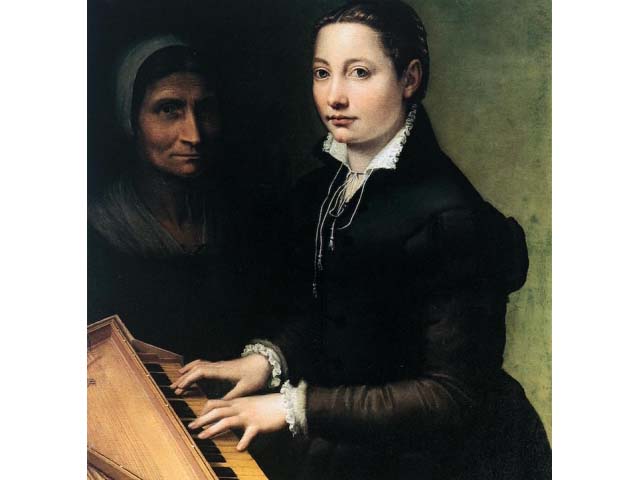
Il padre di Sofonisba la incoraggiò a proseguire gli studi, mandandola a Roma, dove fu presentata a Michelangelo, che rimase colpito dai suoi schizzi. Deliziato dalla sua capacità di catturare le emozioni sulla carta, Michelangelo prese la giovane donna sotto la sua ala protettiva e, per almeno due anni, continuò di istruirla in un modo informale dandole schizzi che aveva creato per copiare in modo da poter criticare il suo lavoro.
Sofonisba’s father encouraged her to continue her studies, sending her to Rome, where she was introduced to Michelangelo, who was impressed by her sketches. Delighted by her ability to capture emotions on paper, Michelangelo took the young woman under his wing and, for at least two years, continued Sofonisba’s informal tutoring and guidance in person giving her sketches he had created to copy so he could critique her work.
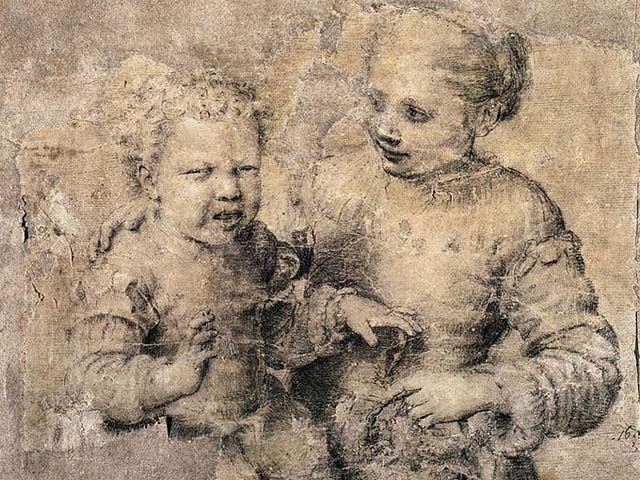
Attraverso i collegamenti del Duca d’Alba, pochi anni dopo, Sofonisba si ritrovò a stabilirsi alla corte della regina spagnola Elisabetta di Valois. La regina, desiderosa di essere le stessa un”artista, invitò Sofonisba ad insegnarle e ad agire come sua confidente, elevandola al grado di dama di compagnia. In questo modo, il talento di Sofonisba divenne più noto a livello globale e col tempo divenne la pittrice ufficiale di corte del re Filippo II.
Through the Duke of Alba’s, connections, a few years later, Sofonisba found herself settling in the court of the Spanish queen Elisabeth of Valois. The queen, keen on being an artist herself, invited Sofonisba to teach her and act as her confidant, raising her to the rank of lady-in-waiting. In this way, Sofonisba’s talent became more globally noted, and in time she became the official court painter to King Philip II.
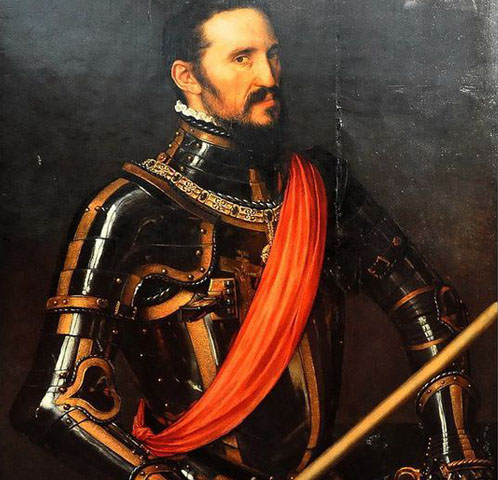
Quando la regina Elisabetta di Spagna morì, il Re si interessò particolarment al benessere di Sofonisba, organizzando un matrimonio co Fabrizio Moncada Pignatelli, figlio del principe di Paternò, viceré di Sicilia. Si dice che Fabrizio, il nuovo marito di Sofonisba, abbia sostenuto la carriera pittorica della moglie e che abbiano avuto un matrimonio stabile, se non felice. Ma, curiosamente, Fabrizio morì nel 1579 in circostanze misteriose. Chi può dire quale sia stata la vera causa? Dopo la morte di Fabrizio, Sofonisba lasciò presto la Sicilia, decidendo di tornare nella sua città natale, Cremona. Fu durante questo viaggio che incontrò e si innamorò del capitano della nave, il mercante di mare Orazio Lomellino, un uomo che si dice fosse di molti anni più giovane di lei. Nonostante le obiezioni del fratello, i due si sposarono nel 1584 e trascorsero le loro giorni insieme a Genova.
When the Spanish Queen Elisabeth passed away, the King took a particular interest in the well-fare of Sofonisba, arranging a marriage to Fabrizio Moncada Pignatelli, son of the Prince of Paternò, Viceroy of Sicily. It is said the Sofonisba’s new husband, Fabrizio supported his wife’s painting career and that they had a polite, if not a happy marriage. But, curiously, he died in 1579 under mysterious circumstances. Who can say what the actual cause was? After Fabrizio’s death, Sofonisba soon left Sicilia, deciding to return to her city of birth — Cremona. It was during this voyage that she met and fell in love with the ship’s captain, sea merchant Orazio Lomellino, a man rumored to be many years younger than she. Despite her brother’s objections, the two married in 1584 and lived out their days together in Genoa.
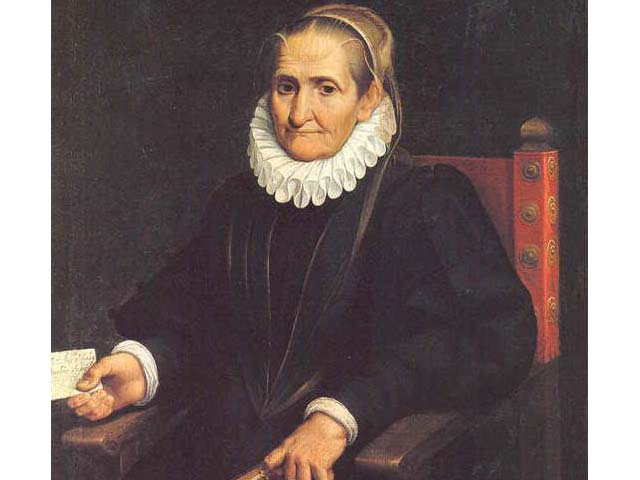
Anthony van Dyck visitò Sofonisba pochi anni prima che morisse.
Lei aveva 90 anni.
Anthony van Dyck visited Sofonisba
a few years before she died. She was in her 90s
Dopo che Anthony van Dyck un artista fiammingo visitò Sofonsiba scrisse: la sua vista era indebolita, ma la signora Anguissola era ancora mentalmente vigile. Il nostro tempo insieme è stato breve, ma le nostre conversazioni mi hanno insegnato di più sui “veri principi” della pittura che su qualsiasi altra cosa nella mia vita.”
After Anthony van Dyck a Flemish artist visited Sofonsiba he wrote: her eyesight was weakened, but the lady Anguissola was still mentally alert. Our time together was short, but our conversations have taught me more about the “true principles” of painting than anything else in my life.”
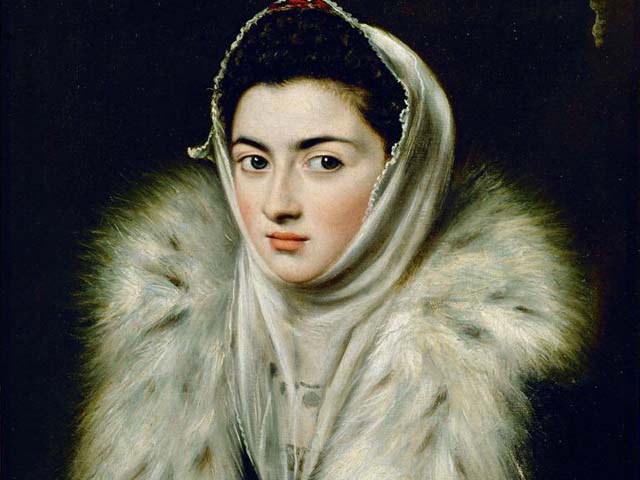
Che vita lunga e coraggiosa ha avuto Sofonisba! Una pittrice di talento in un mondo di uomini, ammirata dal Vasari e insegnato da Michelangelo, promosso da Duca d’Alba e il venerato pittore di corte spagnolo di Filippo II e fiduciosa della sua regina. Sofonisba era una donna che ha seguito il suo cuore e ha trovato l’amore in alto mare… un ispirazione per le future generazioni di pittori.
What a long and courageous life Sofonisba had! A talented female painter in a man’s world, admired by Vasari and taught by Michelangelo, the protegee of the Duke of Alba, and the revered Spanish court painter of Philip II and confident to his queen. Sofonisba was a woman who followed her heart and found love on the high seas… an inspiration to future generations of painters.
